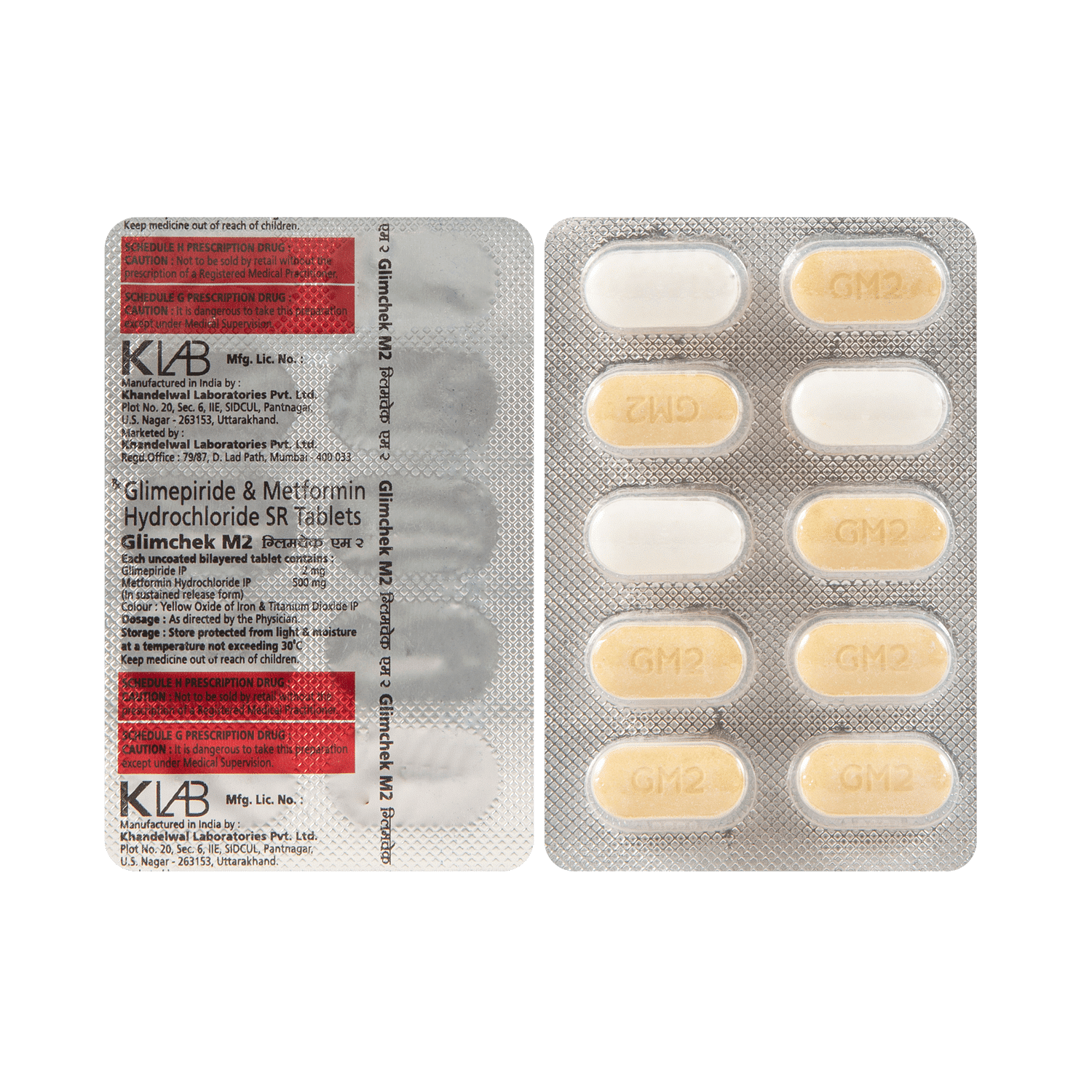
Swimet 2 mg/500 mg Tablet
Manufacturer
Ind Swift Laboratories Ltd
Salt Composition
Glimepiride (2mg) + Metformin (500mg)
Key Information
Short Description
Swimet 2 mg/500 mg Tablet is an anti-diabetic drug used to treat type 2 diabetes mellitus in adults by controlling blood sugar levels.
Dosage Form
Tablet
Introduction
Swimet 2 mg/500 mg Tablet is a combination of two medicines, Glimepiride and Metformin, used to manage type 2 diabetes mellitus in adults. It helps control blood sugar levels by increasing insulin release from the pancreas and reducing glucose production in the liver. While effective, it may cause side effects such as hypoglycemia, especially when combined with other antidiabetic medications or alcohol. Patients should monitor their blood sugar levels regularly and consult their doctor if they experience symptoms like rapid breathing, persistent nausea, or jaundice. It is important to follow the prescribed dosage and take the medicine with food to avoid stomach upset.
Directions for Use
Take this medicine in the dose and duration as advised by your doctor. Swallow it whole without chewing, crushing, or breaking it. Swimet 2 mg/500 mg Tablet should be taken with food.
How it works
Swimet 2 mg/500 mg Tablet combines Glimepiride, which increases insulin release from the pancreas, and Metformin, which lowers glucose production in the liver, delays glucose absorption from the intestines, and increases the body's sensitivity to insulin.
Quick Tips
You have been prescribed this combination medicine as it can control blood sugar better than metformin alone. Continue to exercise regularly, eat a healthy diet, and take your other diabetes medicines along with Swimet 2 mg/500 mg Tablet. Take it with food to lower your chance of having an upset stomach. Monitor your blood sugar level regularly while you are taking this medicine. It can cause hypoglycemia (low blood sugar level) when used with other antidiabetic medicines, alcohol, or if you delay or miss a meal. Inform your doctor about your diabetes treatment if you are due to have surgery under a general anesthetic. Tell your doctor immediately if you experience any deep or rapid breathing, persistent nausea, vomiting, and stomach pain as Swimet 2 mg/500 mg Tablet may cause a rare but serious condition called lactic acidosis. Your doctor may check your liver function regularly. Inform your doctor if you develop symptoms such as abdominal pain, loss of appetite, or yellowing of the eyes or skin (jaundice).
Related Medicines

Diaprid-M 2mg/500mg Tablet

Glucut 2 MT Tablet

Glimoris M 2mg/500mg Tablet

Metossil M 2mg/500mg Tablet

Gluvoiz M 2mg/500mg Tablet

Endoglim M 2mg/500mg Tablet

MG Diab 2mg/500mg Tablet

Kyrambol M2 Tablet

Glimchek M 2mg/500mg Tablet

Glimibert-M 2 Tablet
Frequently asked questions
What are the recommended storage conditions for Swimet 2 mg/500 mg Tablet?
Keep this medicine in the container or the pack it came in, tightly closed. Store it according to the instructions mentioned on the pack or label. Dispose of the unused medicine. Make sure it is not consumed by pets, children, and other people.
Can Swimet 2 mg/500 mg Tablet lead to lactic acidosis?
Yes, the use of Swimet 2 mg/500 mg Tablet can lead to lactic acidosis. It is a medical emergency caused by increased levels of lactic acid in the blood. This is also known as MALA (Metformin-associated lactic acidosis). It is a rare side effect associated with the use of metformin, and therefore considered harmful for patients with underlying kidney disease, older age, or those taking large amounts of alcohol. Symptoms of lactic acidosis may include muscle pain or weakness, dizziness, tiredness, feeling of cold in arms and legs, difficulty in breathing, nausea, vomiting, stomach pain, or slow heart rate. If you experience these symptoms, stop taking Swimet 2 mg/500 mg Tablet and consult your doctor immediately.
What is Swimet 2 mg/500 mg Tablet?
Swimet 2 mg/500 mg Tablet is a combination of two medicines: Glimepiride and Metformin. This medicine is used in the treatment of type 2 diabetes mellitus (DM). It improves blood glucose levels in adults when taken along with proper diet and regular exercise. Glimepiride lowers blood glucose levels by increasing insulin release from the pancreas. Metformin works by lowering glucose production in the liver and improving insulin sensitivity. This combination is not indicated for the treatment of type 1 DM.
What are the possible side effects of Swimet 2 mg/500 mg Tablet?
The use of Swimet 2 mg/500 mg Tablet is associated with common side effects like hypoglycemia (low blood sugar level), altered taste, nausea, stomach pain, diarrhea, and headache. It can also lead to serious but rare side effects like lactic acidosis. On long-term use it can also lead to Vitamin B12 deficiency.
Can the use of Swimet 2 mg/500 mg Tablet cause Vitamin B12 deficiency?
Yes, the use of Swimet 2 mg/500 mg Tablet can cause Vitamin B12 deficiency on long-term use. It interferes with the absorption of Vitamin B12 in the stomach. If untreated, it may cause anemia and nerve problems. Symptoms include tingling sensation and numbness in hands and feet, weakness, urinary problems, change in mental status, and difficulty in maintaining balance (ataxia). To avoid such problems, some researchers suggest an intake of Vitamin B12 from outside sources at least once every year.
Can the use of Swimet 2 mg/500 mg Tablet cause hypoglycemia?
Yes, the use of Swimet 2 mg/500 mg Tablet can cause hypoglycemia (low blood sugar level). Symptoms include nausea, headache, irritability, hunger, sweating, dizziness, fast heart rate, and feeling anxious or shaky. It happens more often if you miss or delay your food, drink alcohol, over-exercise, or take other antidiabetic medicine along with it. So, regular monitoring of the blood sugar level is important. Always keep a quick source of sugar like glucose tablets, honey, or fruit juice with you.
Is it safe to take alcohol while I am also taking Swimet 2 mg/500 mg Tablet?
No, it is not safe to take Swimet 2 mg/500 mg Tablet along with alcohol. This can lower your blood sugar levels and lead to hypoglycemia. It can also increase the chances of lactic acidosis.


